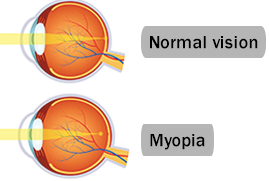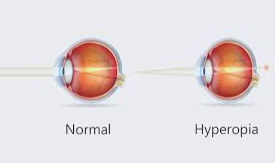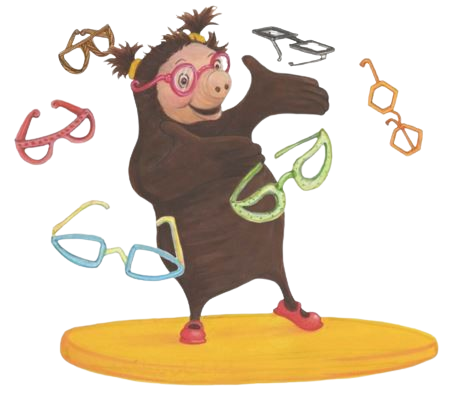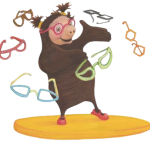A refractive disorder is caused by changes in the shape of the eye which prevent light from being focused sharply on the retina. This creates unclear images and often necessitates optical correction.
Refractive disorders of the eyes seen in children:
- Myopia
- Hyperopia
- Astigmatism
It’s important for children to get eye screenings and comprehensive eye exams regularly because often children don’t notice symptoms of refractive errors until it is too late – especially if the vision loss is only in one eye. If left uncorrected before the age of 7 years old, any of these refractive errors can lead to amblyopia – which is permanent visual impairment in one eye or both (see section below). This can in turn have a profound impact on an infant’s development by restricting them socially, physically and educationally.
What is Myopia (nearsightedness)?
Myopia, also known as nearsightedness, makes far-away objects look blurry. This refractive disorder of the eye occurs when the eye is too long, and light is focused in front of the retina instead of on it.

In the last few years, the prevalence of myopia has increased due to children spending more time on near screens and less time playing outdoors. The WHO predicts that by 2050 more than half the world’s population will have myopia, and more than 10 percent will have high myopia, which can be very damaging for eyesight because high myopia is associated with ocular complications.
The most common treatments for nearsightedness are eyeglasses or contact lenses but now with myopia on the rise we have special optical and pharmaceutical options to slow down myopia.
Adults can also get refractive surgery to treat nearsightedness if they meet the necessary criteria.
What is Hyperopia (farsightedness)?
Hyperopia, also known as farsightedness, makes nearby objects look blurry. This refractive disorder of the eye occurs when the eye is too short, and light is focused in behind of the retina instead of on it.

Common symptoms of hyperopia can include eye strain, trouble seeing up close and headaches when reading.
In mild cases of farsightedness, children will most likely not complain because their distance vision is still good – sometimes they can even still see 20/20. However, they may have trouble reading and can even experience learning difficulties. Sometimes hyperopia does not even appear in eye screenings and based on symptoms alone these children are referred to an eye doctor who will do further investigation by using eye drops.
The most common treatments for farsightedness are eyeglasses or contact lenses. Your eye doctor will prescribe the right lenses to help you see as clearly as possible. When children reach the age of 18 years old they may become candidates for refractive surgery. The surgery changes the shape of your cornea so that it can focus light clearly.
What is Astigmatism?
Astigmatism is a common eye problem that can make vision blurry or distorted. It happens when the cornea (the clear front layer of your eye) is shaped oval like an egg instead of being shaped round like a ball. The shape makes light bend differently as it enters the eye, causing a refractive error. This causes blurred vision at all distances. Astigmatism can be present alone or in combination with myopia (nearsightedness) and hyperopia (farsightedness). Children with mild astigmatism may not notice any vision loss but may notice mild headaches and problems focusing. Children with high astigmatism will have distorted, blurred and sometimes doubled vision at all distances.

There’s no way to prevent astigmatism and it is unclear what causes astigmatism. For instance, some people are born with astigmatism, but many people develop it as children or young adults. Some people may also develop astigmatism after an eye injury or an eye surgery.
Astigmatism is treated with eyeglasses or contact lenses. Above 18 years old they may become candidates for refractive surgery.
What is amblyopia?
The process which allows vision to develop to its full potential happens before the age of 7 years old. Anything that interferes with this process can cause amblyopia (also called lazy eye). Amblyopia is poor vision that is irreversible in adulthood and occurs usually in one eye but sometimes in both. It results when the brain can’t recognize the sight from one eye (or both) Amblyopia starts in childhood, and it’s the most common cause of vision loss in kids. Up to 3 out of 100 children have it.
Causes of amblyopia (lazy eye):
- refractive error These include common vision problems like nearsightedness (having trouble seeing far away), farsightedness (having trouble seeing things up close), and astigmatism (which can cause blurry vision). Normally, these problems are easy to fix with glasses or contacts. But if they’re not treated, the brain may start to rely more on the eye with stronger vision.
- Strabismus (eye turn) Usually, the eyes move together as a pair. But in kids with strabismus, the eyes don’t line up. One eye might drift in, out, up, or down.
- Eye diseases that interfere with the normal development of vision (such as cataracts). This causes cloudiness in the lens of the eye, making things look blurry. While most cataracts happen in older people, babies and children can also develop cataracts.
Over time, the brain relies more and more on the stronger eye while the vision in the weaker eye progressively gets worse.
The importance of vision screenings
Early detection and treatment can save a child’s vision. Early vision screenings are so important because symptoms of amblyopia can be hard to notice – especially when it is only in one eye. Even the parents don’t know their child has amblyopia until a doctor diagnoses it during an eye exam. Sadly, children usually don’t complain either, because it is the world they have always seen and experienced and their benchmark for what is normal sight.
Kids with amblyopia may have poor depth perception. Parents may notice signs that their child is struggling to see clearly such as squinting, shutting their eye, tilting their head. That’s why it’s important for all kids to get a vision screening at least once between ages 3 and 5.
Some kids are born with amblyopia and others develop it later in childhood. The chances of having amblyopia are higher in kids who:
- Were born early (premature)
- Were smaller than average at birth
- Have a family history of amblyopia, childhood cataracts, or other eye conditions
- Have developmental disabilities
What’s the treatment for amblyopia?
Early detection and treatment may be all that is required to avoid vision loss. Kids who are not treated during the critical years of eye development will end up with permanent vision loss. The older the child is the harder it is to treat the vision loss.
Treatments:
- Glasses/Contact lenses: If there’s a vision problem causing amblyopia this needs to be treated as soon as possible. For example, doctors may recommend glasses or contacts (for kids who are nearsighted or farsighted) or surgery (for kids with cataract).
- Patching: In cases where there has already been some vision loss it is necessary to re-train the brain and force it to use the weaker eye. The more the brain uses it, the stronger it gets. By covering up the good eye with an eye patch, the brain has to use the weaker eye to see.
- Eye drops: Certain eye drops can temporarily blur near vision, which forces the brain to use the other eye. For some kids, this treatment works as well as an eye patch, and some parents find it easier to use (for example, because young children may try to pull off eye patches).
After your child starts treatment, their vision may improve within a few weeks, but optimal results will probably take months and regular vision exams are important to monitor vision and maintain it.






